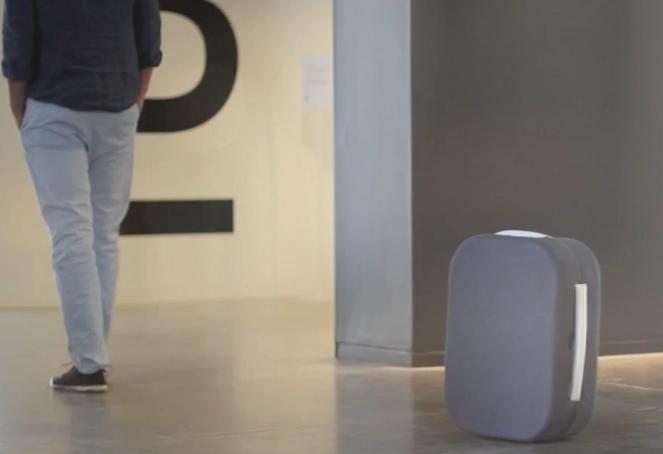Every Friday, Future Tense rounds up the best robot videos of the week. Seen a great robot video? Tweet it to @FutureTenseNow, or email us.
This week we meet a suitcase that won’t let you out of its sight, a rover that makes a real mess, and a team that joins forces to save the planet.
The Hop-Along Bot
Whoever first put wheels to the bottom of a suitcase was a genius, but even still, nobody wants to lug their heavy bags around the airport. Finally robots can step in to give those wheels some power. Spanish designer Rodrigo Garcia Gonzalez created Hop!, a suitcase that uses computers, mobile phones, and caterpillar tracks to follow closely behind its owner. The suitcase connects to a user’s phone via Bluetooth to ensure that it stays near. And no need to keep turning around to check on your bag—if Hop! gets too far away or if the connection is interrupted, the suitcase locks itself, and the phone it was paired with will start vibrating. On the webpage for Hop!, Gonzalez says the system could someday do the job of airport conveyor belts, but for now it can help you make sure you never leave your luggage unattended.
Via ReadWriteWeb.
The Ramped-Up Bot
We’ve all been there. Standing in a restaurant, waiting for a table, and wondering what one could possibly do with all those toothpicks in the dispenser. (That’s not just me, right?) Now Harvard’s Self-Organizing Systems Research Group and the Worcester Polytechnic Institute have created a device to put those little twigs to good use. When something blocks its path, this resourceful rover uses whatever tools it has to build a ramp and roll over the obstacle. First, we see the robot applying glue to toothpicks and randomly flinging them until it has a ramp sturdy enough so it can roll to the top of the box in front of it. In the second part of the video, it uses a urethane casting foam to achieve the same goal. Both approaches are messy and haphazard, but inspired by nature. The toothpick approach mimics birds or beavers building their homes, and the foam imitates termites building with mud. The device shows how machines could overcome unpredictable obstacles with whatever is at their disposal.
Via Gizmodo, IEEE Spectrum.
The Wiggly Bot
Air-powered robots have many benefits, but graceful movement isn’t one of them. This device, a project of the Italian Institute of Technology and Kings College London, uses air pressure to control its legs—allowing it to stand up and walk (or flail) about. Though it may not look pretty, the soft internal tubes that keep this bot upright mean it’s not nearly as delicate or expensive as traditional metal robots built of heavy, inflexible metal. For now, this bot is tethered to an off-board air pump, and if it can be set free in the future, it could be used to explore other planets, swim underwater, or even scope out landmines. The design was inspired by octopus tentacles, making this robot the perfect tribute for this week’s Cephalopod Awareness Days.
Via NBCNews.
The Team Bots
Robots have proven they’re great at working together—whether they’re building a structure, putting on a light show, or playing the James Bond song. Now we can add “saving the coral reef” to that list. The autonomous swarming system seen here was designed by a team of researchers at McGill University, Universite Laval, and the University of Guelph, all of which are in Canada. The project integrates an autonomous airplane to provide large aerial imagery of an area, an autonomous submarine to take up-close photos of underwater sites, and an autonomous boat to help the other two communicate. Together, they survey coral reef and provide detailed information much more efficiently than a team of humans doing the same thing. The bots don’t need much direction from people, and researchers can even control the team through an online interface—as though anyone ever wanted an excuse to stay home instead of going to the ocean.
Via IEEE Spectrum.
